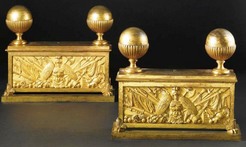Ormolu
Ormolu, an 18th-century English term, is from the French phrase or moulu, with “or” indicating gold and “moulu” being a form of an old French verb moudre, which means “to grind up.” (This French term for this technique is bronze dore.) This idea of “ground-up gold”refers to the production process of ormolu, where high-quality gold is finely powdered and added to a mercury mixture and applied to a bronze object. Modern usage often uses “ormolu” to describe any gilded object.
In reality, true ormolu pieces produced by this process are very rare. Production of ormolu declined dramatically after the first quarter of the 19th century, partly because of the great expense of the gold, but also because of the terrible health risks involved. “Mercury gilding,” the process of manufacturing ormolu, requires the application of a solution of mercury nitrate to the object (which is normally of copper, brass or bronze), and then the application of the gold/mercury amalgam, that was usually 6 to 8 parts of mercury to one part gold. In order for the gold to adhere to the surface, the coated object is placed in a kiln and exposed to extreme temperatures, which burns away the mercury. (This is similar to the technique used to produce vermeil, a form of silver-gilt.) As a result of the intense and prolonged exposure to mercury, it has been estimated that most mercury gilders died before the age of 40, and the process was banned in many countries in the mid-1800s.

True ormolu chenets (French andirons) from the Empire period attributed to Claude Galle. (p4A item # D9819758)
As fashion (and economics) dictated, gilding shifted in and out of popularity. Various methods to achieve the appearance of gilt were experimented with, including a process known as pomponne, which involves a mixture of copper and zinc (occasionally with the addition of tin), but the result here is technically a brass gilding rather than gold. Mechanical or chemical gilding techniques were largely replaced by electroplating by the mid-19th century.
Evaluating Age and Authenticity of Ormolu
Evaluating the age and authenticity of ormolu mounts is one of the most difficult aspects of furniture appraisals because metal does not age in the same way as wood and because the mount’s patina has often been “enhanced” or damaged by inappropriate cleaning. Close inspection of the mounts can reveal much of their history however.
The design of eighteenth century mounts often suggests a certain exuberance and spontaneity; later nineteenth century artisans produced works more perfect in detail but with a more studied air about them. An experienced eye can also detect differences in eras or even between countries from the mount’s coloring, provided the original surface has not been disturbed. One should also take note of the size of each individual mount or sub-component. Bronze mounts of the eighteenth century, particularly furniture mountings, were cast in relatively smaller sections (usually no longer than 10 inches) and then pieced together to obtain the desired overall effect. Mounts of the nineteenth and twentieth centuries tend to be much longer.
Removing a mount from the piece in question (carefully!) can give one the most unambiguous information about its age and authenticity. First consider the casting…the more irregularities present on the underside, the earlier it is likely to be. Nineteenth and twentieth century castings most often have a “cleaner” and “smoother” appearance. More clues are revealed by the mount’s gilding. Early mounts treated with the mercury gilding technique discussed above were gilded on one side only, later mounts gilded with the electrolysis method are gilded on both sides.
As with all elements of an antique item of furniture, the condition of the ormolu mounts can effect the value of the piece itself. Entirely original mounts with original surfaces will increase the piece’s value. Replacement of all or a significant proportion of the mounts may significantly reduce its value, as will inappropriate cleaning of the mounts. The loss or replacement of one or two minor elements, however, may not have much effect at all on the piece’s value, particularly if the original surface remains. Cleaning ormolu mounts is best left to experts; at the most, use no more than mild soap and water with a very soft brush.
p4A.com acknowledges the International Auctioneers Magazine, Autumn 2003, as the source for much of the information in this reference note.
